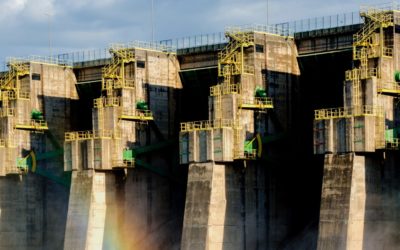Introduction
Robust infrastructure is a pillar of the nation’s vitality, impacting the wellbeing of communities, people, and businesses. It is also an essential underpinning for a healthy economy. Yet many of the nation’s roads, rails and bridges are falling into disrepair, while important aspects of the aviation system are outdated and in need of expansion or renovation, and the waterway system is hampered by aging locks and decades-old infrastructure. The American Society of Civil Engineers’ (ASCE) 2017 Infrastructure Report Card graded overall U.S. infrastructure a “D+,” and attributes the nation’s poor infrastructure condition and performance to decades-long funding gaps estimated at $2 trillion, costing American families $3,400 per year.
Read More…
To address this acute funding lapse and spur investment, on Feb. 7, 2019, a group of bipartisan senators introduced a bill, S. 403, to encourage the research and use of innovative materials and associated techniques in the construction and preservation of the domestic transportation and water infrastructure system, and for other purposes. Companion legislation, H.R. 1159, was introduced in the House one week later. Known as Innovative Materials for America’s Growth and Infrastructure Newly Expanded (IMAGINE) Act, the bills would encourage investing in new techniques and materials, including coatings, that would help to extend the life of critical public works.
The American Coatings Association (ACA) represents the more than $28 billion paint and coatings manufacturing industry in the United States, operating in all 50 states, and employing over 60,000 people engaged in the manufacture and distribution of its products. This Issue Backgrounder highlights the IMAGINE Act framework, and important place coatings have in rebuilding U.S. infrastructure.


Ingredients for Success
The IMAGINE Act is designed to encourage the research and use of innovative construction materials and techniques to speed up the deployment and extend the life of transportation and water infrastructure. It aims to do so by establishing the following: an Interagency Innovative Materials Task Force; Innovative Materials Hub; Research; Innovative Bridge Program; and Water Infrastructure Innovation Program.
Read More…
For some time, DHS has been implementing the terrorist screening portion of the CFATS PSP at all Tier 1 and Tier 2 high-risk facilities — approximately 200 sites. This process requires the facility to collect, manage and protect sensitive personal identifying information on employees and contractors and send that information to DHS for vetting against the TSDB. DHS is planning to extend this program to an additional 3,000 lower risk Tiers 3 and 4 facilities, involving tens of thousands of additional employees and contractors and their personal information. ACA believes that expansion of the PSP program is unnecessary and will needlessly put personal employee information at risk.1 ACA maintains that since Tier 3 and 4 facilities have already been determined to present low-risk, the TSDB requirement is unnecessary for those lower tier facilities, and that DHS should restrict the terrorist screening portion of the CFATS PSP to Tier 1 and Tier 2 facilities.
Interagency Innovative Materials Task Force. Creation of a task force to assess existing standards and test methods for the use of innovative materials in infrastructure, identify key barriers in the standards area that inhibit broader market adoption, and develop new methods and protocols, as necessary, to better evaluate innovative materials. The task force would be chaired by the National Institute of Standards and Technology and bring together the Federal Highway Administration (FHWA), the Army Corps of Engineers (ACE), the Environmental Protection Agency (EPA), and other relevant agencies’ organizations.
Innovative Materials Hub. The Secretary of Transportation, in coordination with leaders of other agencies, would create and designate, through a competitive selection process, the development of innovative material hubs located throughout the United States to further drive research and development of different innovative materials for use in infrastructure projects.
Remarkably, this provision was inspired by the success of communities of materials manufacturers – such as advanced composites makers in Rhode Island and the Institute for Advanced Composites Manufacturing Innovation in Knoxville, Tenn. – that have leveraged their innovations and expertise to grow their industry.
Research. The bill authorizes $8 million for the Turner-Fairbank Highway Research Center to collaborate with relevant state and tribal agencies and other stakeholders to research and develop innovative materials, prioritizing work targeting large span bridges, highway reconstruction and rehabilitation, rural roads, and coastal resiliency.
Notably, “innovative materials” is defined in the bill to include asphalt mixtures and concrete formulations, geo-synthetic materials, advanced insulating materials, advanced alloys and metals, reinforced polymer composites and advanced polymers, nanocellulose and wood-based composites, coatings, highly functional adhesives, and other corrosion prevention methods used in conjunction with those materials, and any other material or aggregate materials as determined by the relevant agencies.
Innovative Bridge Program. The bill authorizes $65 million for the FHWA (FY 2020 to 2024) for a new grant program available for the design and installation of innovative materials in bridge projects. Prioritization consideration would be given for “at-risk” coastal bridge projects, projects in rural areas prone to inland flooding, and bridge retrofits. Domestic sourcing and nontraditional production techniques would also be given preference.
Water Infrastructure Innovation Program. The bill authorizes $65 million for EPA (FY 2020 to 2024) for a new grant program available for the use of innovative materials in the design and installation of wastewater transport and treatment systems and drinking water treatment and distribution systems in small to medium-sized communities. Special consideration would be given to areas prone to saltwater intrusion or flooding.
Coatings Are Key
ACA believes that successful infrastructure legislation must promote innovative technologies and drive solutions that improve the performance of our national infrastructure. By protecting the surfaces to which they are applied, coatings will be a significant contributor to any effort to improve U.S. infrastructure.
Read More…
New, technology-driven coating materials can make our public works safer, more resilient and sustainable, and respond better to extreme weather, rising sea level, and other 21st century challenges like chemical damage. For instance, unprotected steel structures in harsh environments can lose as much as 1 mm in thickness in as little as five years. This loss contributes to structural weakness, and the steel must be replaced. But a thin protective coating applied to the steel can slow or delay the corrosion process and significantly extend the life of the steel by 15 or more years, even in offshore environments.
In practical terms, coatings applied to the San Mateo Bridge in Hayward, California extended the service life of the bridge by an additional 25-45 years.
Coatings are also integral for protecting our water. Protective pipe coatings for water transmission are frequently overlooked but play a vital role: the coatings work as both an internal lining and a corrosion-resistant external coating, for both potable and non-potable water transmission pipelines, acting as a barrier for both mechanical resilience and resistance against both chemical and climactic impact.
The IMAGINE Act will encourage research and deployment of innovative construction materials, including the next generation of coatings that are crucial for transportation and water infrastructure projects nationwide. These materials are often invisible but can lengthen the lifespan of expensive and critical infrastructure and extend capital investments.


A Ready Partner
Going back several decades, each major piece of infrastructure legislation has included provisions that promote innovative technologies and drive solutions that improve the performance of our national infrastructure. ACA believes the IMAGINE Act follows that model, by driving research and incentivizing investments in technologies that will enhance the durability and extend the service life of our built environment. Importantly, this legislation will empower localities in coastal and rural areas to build structures which meet the critical performance they need but lack the resources to construct.
ACA urges Congress to pass the IMAGINE Act and hopes to work with members to build a 21st century infrastructure designed to meet the needs of our 21st century challenges.
CONTACT
For more information, contact:
Heidi McAuliffe
Vice President, ACA Government Affairs
hmcauliffe@paint.org
202-719-3686